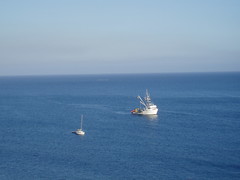With news that the Monterey Bay Aquarium has 
The shark, a 5-foot 8-inch juvenile male, was captured in the waters outside the Santa Monica Bay and kept for several weeks in a floating pen just outside Paradise Cove. If you click on the photo to enlarge it, then squint a little, you'll see the line of white buoys floating above the pen.
From the San Jose Mercury News:
Baby Jaws arrived at the Monterey Bay Aquarium about 6 p.m. Thursday after an arduous nine-hour journey. He was transferred from a 4 million-gallon mesh holding pen off the coast of Malibu to the ``Finnebago,'' a 3,000-gallon oblong tank filled with 68-degree water for the ride up I-5. He'll be living in the Outer Bay exhibit, the aquarium's largest, with large tuna, ocean sunfish and other deep-sea creatures.Because the shark is a protected species, aquarium staff needed a special permit from the California Department of Fish and Game when they caught him with a hook and line several miles offshore in Santa Monica Bay, said aquarium spokesman Ken Peterson.
He spent two weeks swimming in the holding pen and snacking on bonito and other fish before the aquarium deemed him fit for travel. The aquarium had set its hopes on a female shark caught in June, but she died shortly after her capture.
For some critics, that raises questions about whether sharks should be kept in captivity at all.
Until the aquarium's successful six-month shark display last year, no one had been able to keep a great white shark in captivity longer than 16 days. While some scientists believe that not much can be learned about sharks' natural behavior in captivity, Peterson said the new shark exhibit has a larger purpose: to help change the image of a poorly understood species whose numbers are declining worldwide.
After the female shark was released in 2005, scientists tracked her via an electronic tag for a month, discovering that she swam up to 100 miles away and dived to depths of up to 800 feet.
``We know so little about white sharks,'' Peterson said. ``We don't know where they have their pups or where they go. Now we're discovering that they travel as far west as Hawaii to Aņo Nuevo and the Farallon Islands.
``The first step in protecting sharks in the wild is to get people to think about them differently -- to see them as this magnificent animal that has a vital role to play in the ocean ecosystem.''
The aquarium's first white shark, which was caught by fishermen off Huntington Beach and given to the aquarium, was released after it started killing its tank mates in a bout of increasingly aggressive behavior. Abrasions to its snout suggested it was striking the walls of the tank in an effort to swim free.
The Underwater Times got photos of the first shark's injured nose, an online petition to free the shark was launched and then the great fish killed several of its tank mates. The shark was released in March of 2005.





